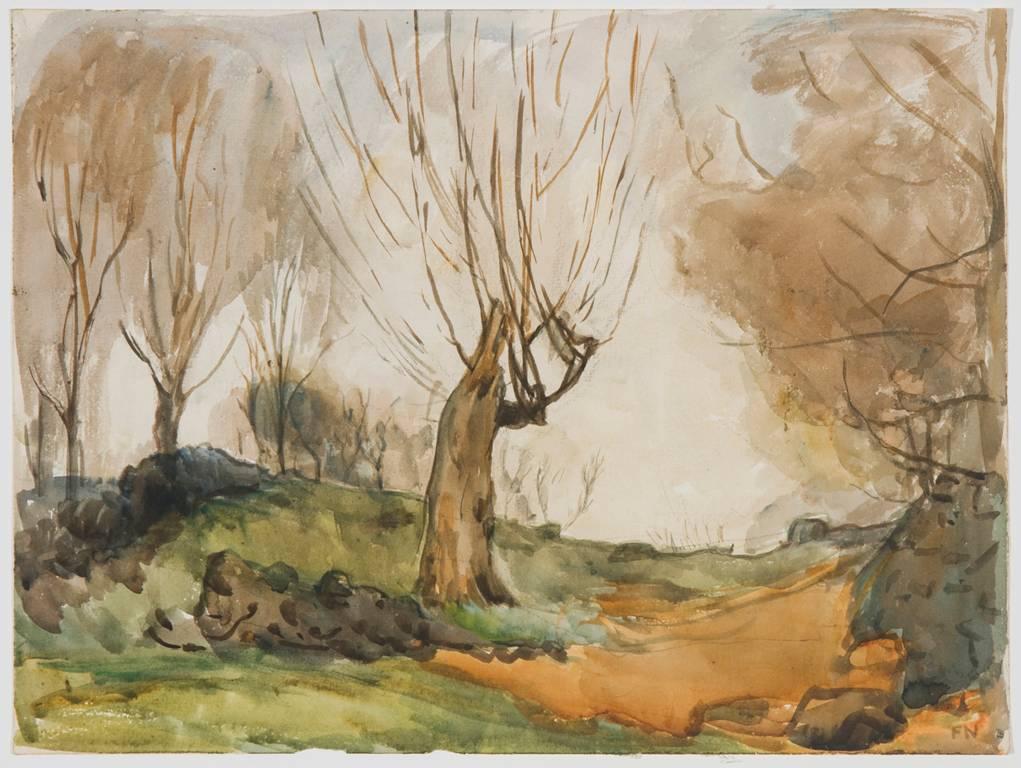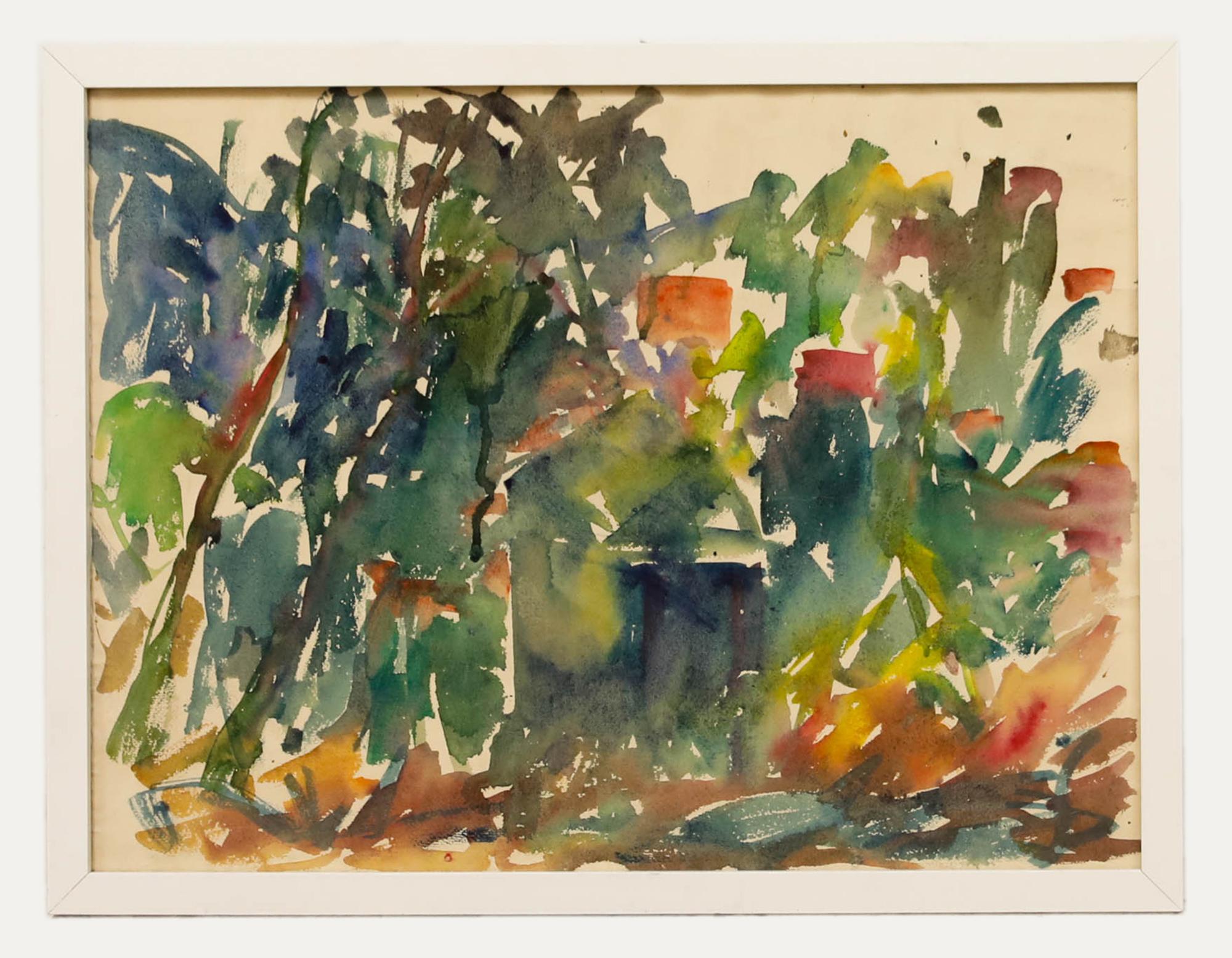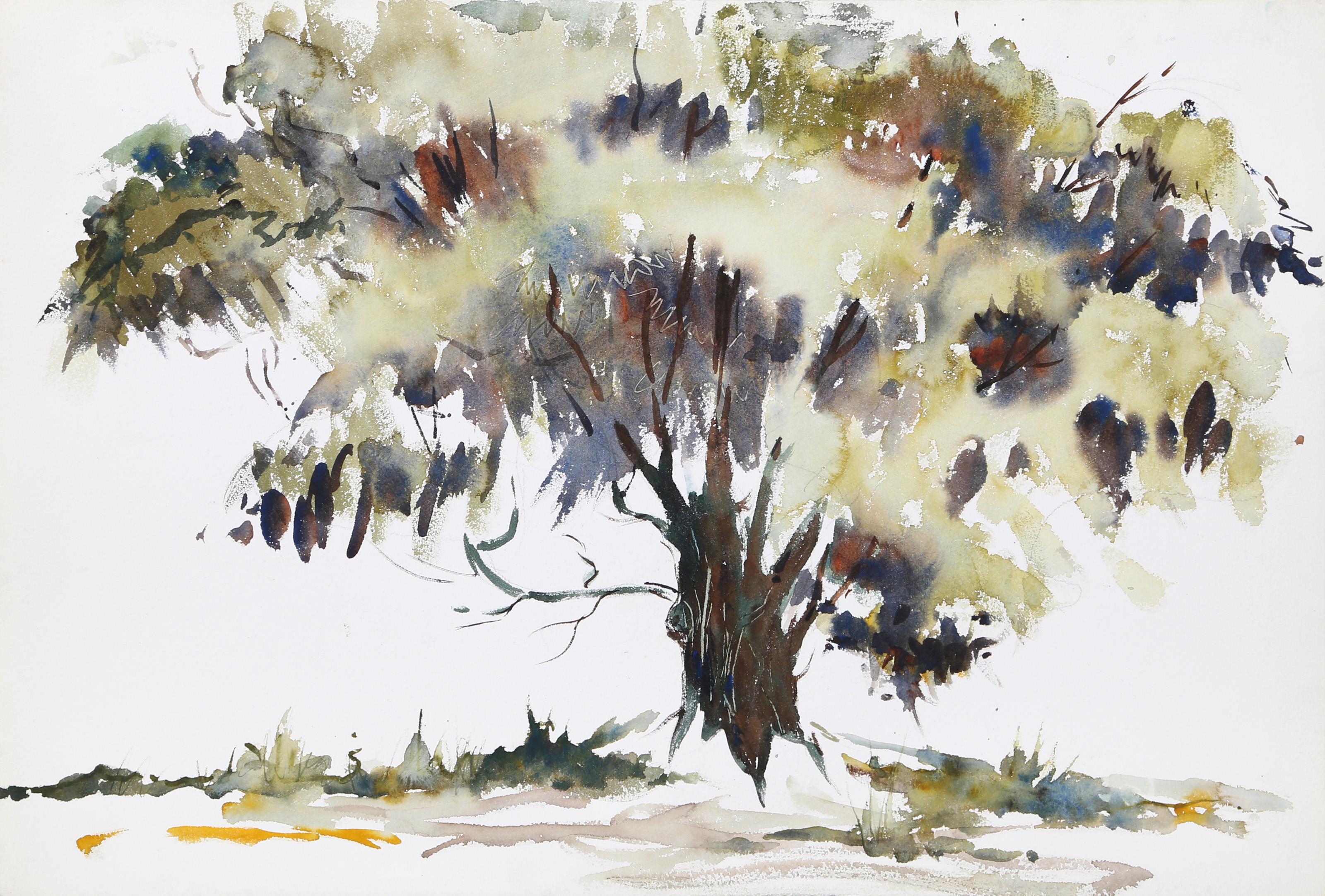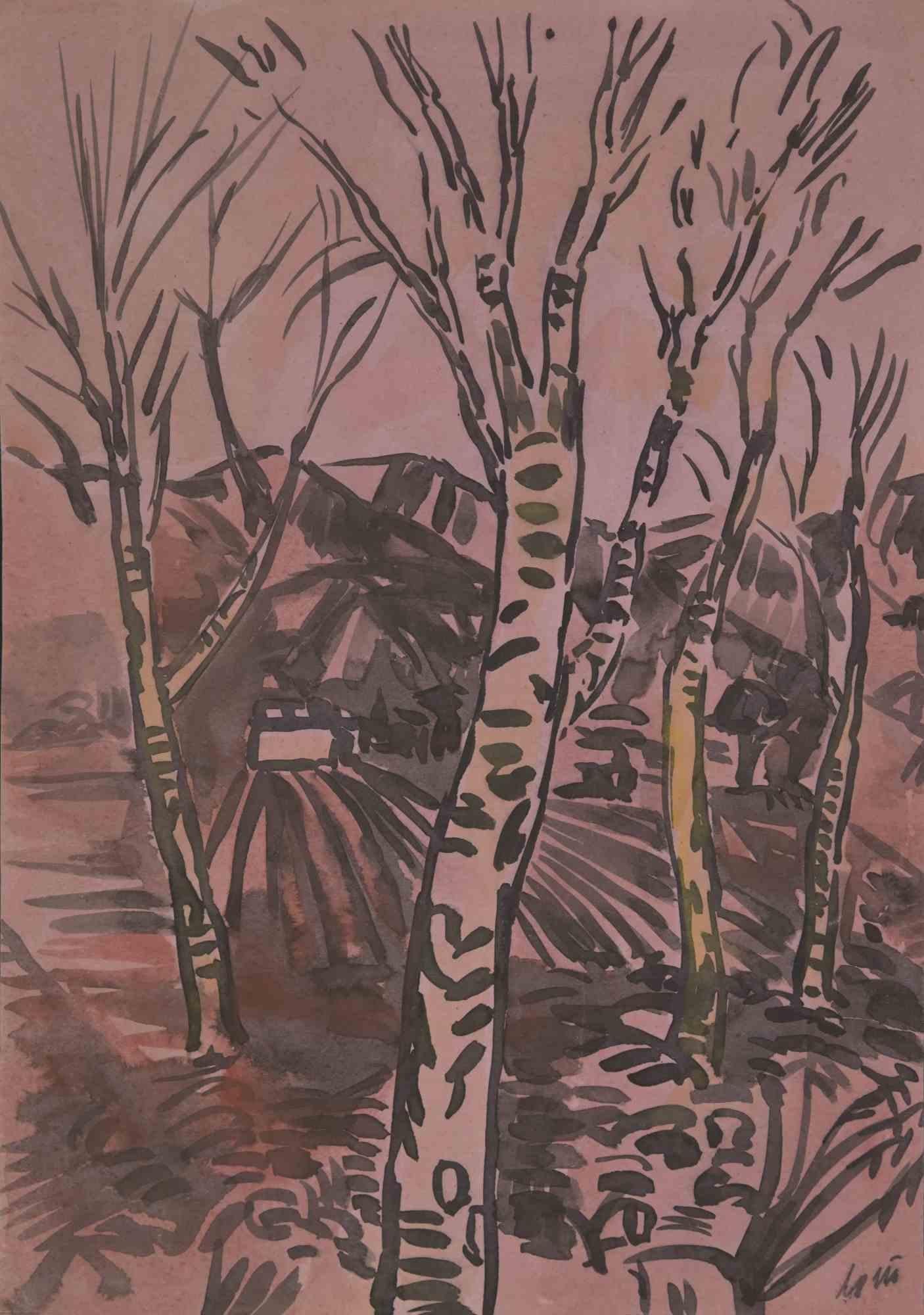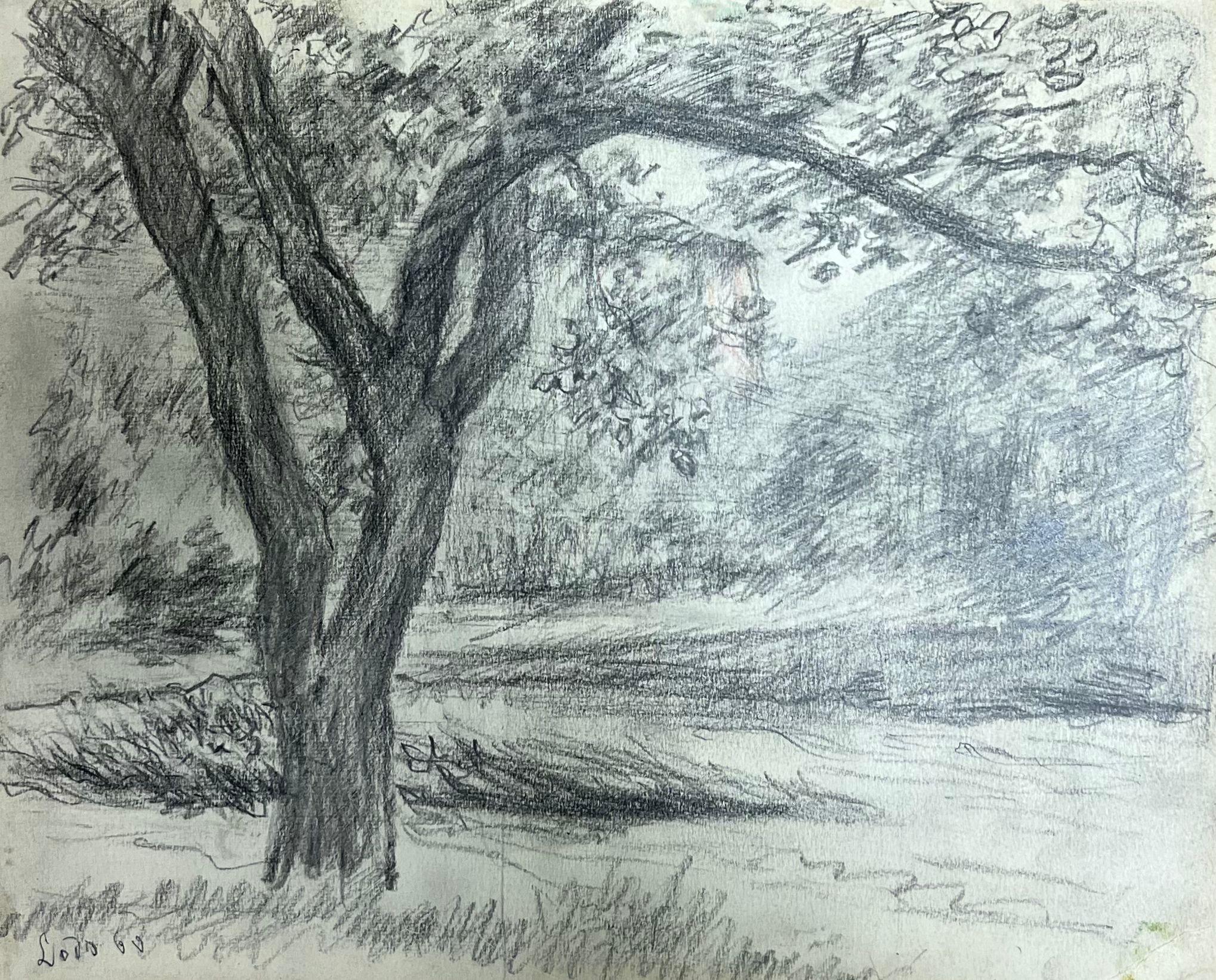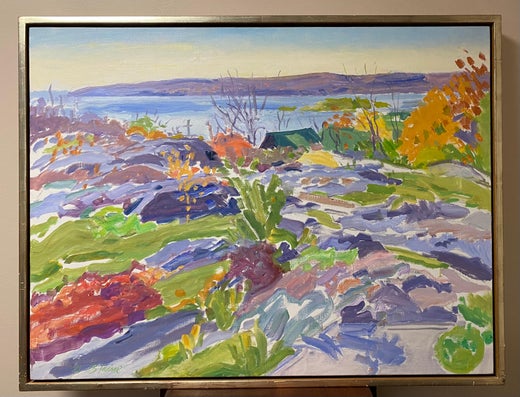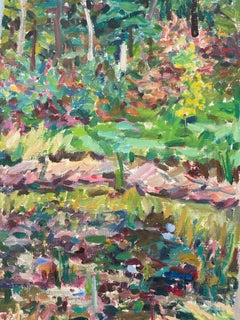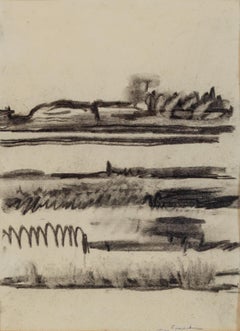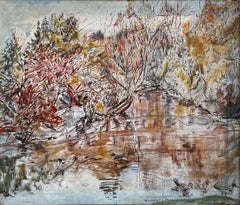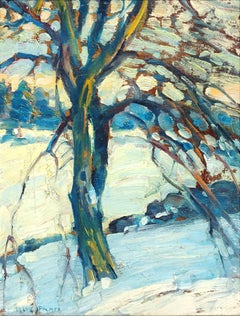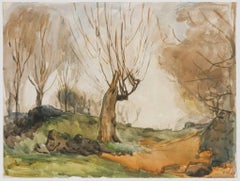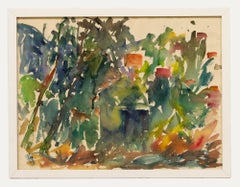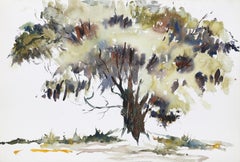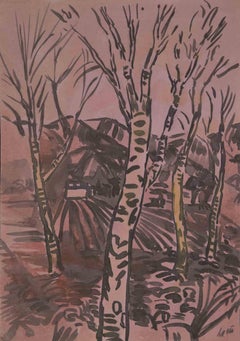Items Similar to "Tree at the Edge of the Field, Springs" Nell Blaine, 1967 Abstracted Landscape
Want more images or videos?
Request additional images or videos from the seller
1 of 11
Nell Blaine"Tree at the Edge of the Field, Springs" Nell Blaine, 1967 Abstracted Landscape1967
1967
$9,500
£7,205.14
€8,275.40
CA$13,610.07
A$14,983.68
CHF 7,658.19
MX$178,834.22
NOK 97,505.10
SEK 91,243.04
DKK 61,812.38
About the Item
Nell Blaine
Tree at the Edge of the Field, Springs, 1967
Signed and dated lower left
Watercolor on paper
14 1/2 x 20 inches
Nell Blaine was born in Richmond, Virginia in 1922. She had a difficult childhood, suffering both physically and emotionally. She underwent several surgeries to correct her extremely poor vision at an early age. Her father, who never got over the death of his first wife, was cold to his daughter, and at times even abusive. He died during the Depression after a long illness that drained the family’s financial resources, leaving little money to provide for his daughter’s future. In the face of all this adversity, however, Blaine was a fighter, and received a working scholarship to the Richmond Professional Institute, an extension of William and Mary College. Unfortunately, the scholarship’s funds ran out, and Blaine was unable to finish her studies. To earn a living, she began working for advertising agencies, doing jobs such as illustrations for the Virginia Chamber of Commerce and Reynolds Metals. Blaine would turn to advertising throughout her life when her finances required it.
Blaine moved to New York City in 1942 at the age of 19, where she said she was “like a bird out of a cage.” She visited the Museum of Non-Objective Art (now the Solomon R. Guggenheim Museum), listened to jazz at the Village Vanguard, and soaked up the culture the bustling city had to offer. She ambitiously enrolled in both the Art Students League and Hans Hofmann’s school. She fully embraced abstraction, and became the youngest member of the American Abstract Artists in 1943. Peggy Guggenheim included Blaine in the exhibition The Women at her Art of This Century Gallery 1945, and Howard Putzel showed her work at his 67 Gallery the following year.
Both Larry Rivers and Jane Freilicher studied under Blaine informally. In 1950 she traveled with Rivers to Paris, a trip that incited her shift away from abstraction and towards representation, a considerably risky move – she was just earning critical acclaim for her abstract works from such respected judges as Clement Greenberg. Upon her return to the states, she started a design service, illustrating exhibition catalogues, drawing cartoons, and even designing the original Village Voice and the first covers for Anchor Books.
By 1956, she was once again on the critics’ and the galleries’ good side, receiving positive feedback for her paintings from nature. She was the subject of an article in Art News, Life included her in an article “Women Painters in Ascendance,” she sold a painting to the Whitney Museum of American Art, and showed regularly with Tibor de Nagy and the Poindexter Gallery in New York.
In 1959, Blaine traded a painting for the use of a studio in Mykonos, Greece. After 5 months, she began to experience curious physical symptoms and was diagnosed with polio. Luckily, the editor of Art News and Blaine’s friend, Thomas Hess, was on a nearby yacht and was able to secure a helicopter to fly her to a hospital in Athens. While there, Blaine underwent several procedures that saved her life, including a tracheotomy, but the illness quickly grew worse. By the time she was moved to Germany, where the closest iron lung was, she could only move her head and her left hand. She was finally transported back to New York, where she remained in the iron lung at Mount Sinai hospital for another five months.
During this traumatic and painful time, however, Blaine never gave up. She was in the hospital for a total of seven months, and despite being told that she would never paint again, she devoted herself to her physical therapy and was soon doodling and giving drawing lessons to the nurses. 79 of her artist friends, including Larry Rivers, the de Koonings, Saul Steinberg, Robert Motherwell, Philip Guston, Jane Freilicher, and Robert Rauschenberg, organized the exhibition To Nell Blaine at the Poindexter Gallery, donating their work to pay for her considerable hospital expenses.
Blaine was back to living and painting in her Riverside Drive apartment by 1960. Elinor Poindexter worked tirelessly to promote Blaine’s career, and this continued support allowed her to produce a steady flow of lyrical works, oils that she painted with her stronger, left hand, and watercolors that she painted with her right. She received several grants, including from the Guggenheim and the National Endowment for the Arts. Blaine attended few openings, but remained in touch with her several friends through correspondence. She purchased a summer home in Gloucester, Massachusetts, whose seaside views and quaint town became subjects in her work. Blaine fully acknowledged that painting was her form of escapism; her works are vibrant and cheerful because that is how she felt when she painted them. She continued with her positive outlook on life and her art until 1996, when she died at age 74 in New York City from respiratory failure brought on by post-polio syndrome.
- Creator:Nell Blaine (1922 - 1996, American)
- Creation Year:1967
- Dimensions:Height: 14.5 in (36.83 cm)Width: 20 in (50.8 cm)
- More Editions & Sizes:Unique WorkPrice: $9,500
- Medium:
- Movement & Style:
- Period:
- Condition:
- Gallery Location:New York, NY
- Reference Number:1stDibs: LU1841215578792
Nell Blaine
Nell Blaine, painter of still lifes and landscapes in brilliant colors, created abstract work that gives the appearance of being done in a carefree, totally lighthearted manner but in fact is the result of years of disciplined study. It is also an effect achieved after rehabilitation from polio, which nearly took her life. Suffering a paralyzed right hand, she taught herself to paint with her left hand, and she devoted much time to applying colors, some times as many as fifty varieties. She attributed her fascination with color with its discovery when she was two years old and corrective eye surgery allowed her to see color for the first time. Blaine was raised in the Richmond, Virginia, where she grew to hate the prevalent racial discrimination and left home at an early age. In high school, she was skilled enough to begin selling her artwork, which was mostly posters and portraits. She attended the Richmond School of Art, now Virginia Commonwealth University, between 1939 and 1942 but left its classical realist curriculum when one of the instructors introduced her to modern art. She used money she had earned from commercial art and went to New York and studied with Hans Hofmann, teacher of Abstract Expressionism. Shortly after, she married a jazz musician and immersed herself in the world of jazz, beating drums and improvising expressive dances, and associating with Charlie Parker, Dizzie Gillespie, and Beat Generation writer Jack Kerouac. Her paintings of that time reflect her strong developing sense of relationship between jazz and abstract art. In 1944 at age twenty two, she became the youngest member of the American Abstract Artists and exhibited hard-edged geometric paintings, mostly black and white with accents of bright colors. She joined a cooperative of abstract artists and worked so hard at organizing shows that some referred to it as the Blaine Street Gallery. She was a strong personality who had special influence on Larry Rivers and Jane Freilicher and appeared to thrive in the New York art scene of the 1940s. However, she decided that her lifestyle was unhealthy, and she left the city, had a period of seclusion, and then went to France where she admired the work of Gustave Courbet, Jean Antoine Watteau, Eugene Delacroix, and Nicholas Poussin and took up figurative art in an abstract style. She became known as a "painterly realist," and added landscapes and interiors to her subject matter. She earned fellowships to Yaddo and the MacDowell Colony and began spending at least half the year in Gloucester, Massachusetts. She also traveled in Mexico. In 1959 on the island of Mykonos, Greece, she had polio. Her New York art friends in an exhibition of seventy-one artists raised money for extensive treatment at Mount Sinai Hospital. After recovery, she settled in a studio on Riverside Drive, spent her summers in Gloucester, and painted from her wheelchair. She died in 1996.
About the Seller
5.0
Platinum Seller
Premium sellers with a 4.7+ rating and 24-hour response times
Established in 2022
1stDibs seller since 2022
126 sales on 1stDibs
Typical response time: <1 hour
- ShippingRetrieving quote...Shipping from: New York, NY
- Return Policy
Authenticity Guarantee
In the unlikely event there’s an issue with an item’s authenticity, contact us within 1 year for a full refund. DetailsMoney-Back Guarantee
If your item is not as described, is damaged in transit, or does not arrive, contact us within 7 days for a full refund. Details24-Hour Cancellation
You have a 24-hour grace period in which to reconsider your purchase, with no questions asked.Vetted Professional Sellers
Our world-class sellers must adhere to strict standards for service and quality, maintaining the integrity of our listings.Price-Match Guarantee
If you find that a seller listed the same item for a lower price elsewhere, we’ll match it.Trusted Global Delivery
Our best-in-class carrier network provides specialized shipping options worldwide, including custom delivery.More From This Seller
View All"Tree Landscape" Charles DuBack, Green Decorative with Pond and Forest, Modern
Located in New York, NY
Charles DuBack
Tree Landscape, 1987
Signed and dated lower right
Oil on canvas
21 x 16 inches
Charles Steven DuBack was born in Fairfield, Connecticut in 1926, the first (of ten) bo...
Category
1980s Landscape Paintings
Materials
Canvas, Oil
"Untitled I" Jane Freilicher, Hamptons Landscape Drawing, Mid-century Abstract
By Jane Freilicher
Located in New York, NY
Jane Freilicher
Untitled I, 1958-59
Signed lower right
Charcoal on paper
11 1/2 x 8 3/4 inches
Provenance:
Tibor de Nagy Gallery, New York
Private Collection, New York
Jane Freilic...
Category
1950s Modern Landscape Drawings and Watercolors
Materials
Paper, Charcoal
"Woodland and Stream" Theresa Bernstein, Red Green Yellow Abstracted Landscape
By Theresa Bernstein
Located in New York, NY
Theresa Bernstein
Woodland and Stream, circa 1980
Signed Lower Right
Oil on canvas
19 x 23 inches
Theresa F. Bernstein was born in Philadelphia in 1895 to cultured, middle-class im...
Category
1980s Expressionist Figurative Paintings
Materials
Oil, Canvas
"Tree in Winter" Delos Palmer Jr, Sketch of Tree 20th Century Impressionist Work
Located in New York, NY
Delos Palmer Jr.
Tree in Winter
Signed lower left
Oil on Masonite
10 x 8 inches
Delos Palmer, Jr. was born January 26, 1890 in New York City. His father was Dr. Delos Palmer, a socially prominent Park Avenue dentist. His mother was Jennifer Emma Banta. His parents were both born in NYC, where they married in 1880 and had five children. There had three sons and two daughters. He was the fourth born. They lived in a private townhouse at 48 West 50th Street, with a cook, a waitress, and a nurse to assist in his father's dental practice on the ground floor.
They lived a privileged life and the children all went to the best private schools. He graduated high school in June of 1908.
He studied at The Art Students League from 1911 to 1915 with the renowned American Impressionist, George Bellows. According to the artist, "Bellows was a good influence on me. He taught me how to paint what I see and what I feel!"
In 1916 Palmer moved to the historic Holbein Studios at 139 West 55th Street. He worked there until 1920, when he moved to the more fashionable Greenwich Village, where he became a successful society portraitist.
He was 27 years old during the Great War, so he was not selected for military service.
In 1923 Palmer began to sell interior story illustrations to Metropolitan Magazine, The Saturday Evening Post, and Liberty.
In 1924 he married Helen Smith Romme and moved to Stamford, CT, where they raised a daughter and two step-sons.
The fateful market crash of 1929 ended Palmer's high society portrait business, but he soon found work through his contacts at Liberty magazine's MacFadden Publishing, which also produced several crime and detective magazines such as Master Detective and True Detective.
He then began to paint pulp covers for Dime Mystery, Clues, Frontier Stories, Action Stories, Western Trails, All Star Adventure, Complete Western Book...
Category
Early 20th Century American Impressionist Figurative Paintings
Materials
Masonite, Oil
$1,200 Sale Price
20% Off
"Tree, Trunk, and Roots, New York" Joseph Stella, American Modernism
By Joseph Stella
Located in New York, NY
Joseph Stella (1877 - 1946)
Tree, Trunk, and Roots, Bronx, New York, circa 1924
Oil on canvas
12 x 16 inches
inscribed in another hand Joseph Stella/Estate and bears Joseph Stella Estate stamp (on the reverse)
Provenance:
The Estate of the Artist
Rabin & Kreuger, New Jersey
Parke Bernet Galleries, New York, March 14, 1968, Lot 147
ACA Galleries, New York
Thence by descent
Stella was born June 13, 1877 at Muro Lucano, Italy, a mountain village not far from Naples. He became painter laureate of Muro Lucano when he was in his teens with a representation of the local saint in the village church. Stella immigrated to America in 1896 and studied medicine and pharmacology, but upon the advice of artist friend Carlo de Fornaro, who recognized his undeveloped talent, he enrolled at the Art Students League in 1897. Stella objected to the rule forbidding the painting of flowers, an indication of his lifelong devotion to flower painting. He also studied under William Merritt Chase in the New York School of Art and at Shinnecock Hills, Long Island in 1901-1902, displaying the bravura brushwork and dark Impressionist influence of Chase.
Stella liked to paint the raw street life of immigrant society, rendering this element more emotionally than the city realists, the Aschcan School headed by Robert Henri. Stella went through a progression of styles--from realism to abstraction--mixing media and painting simultaneously in different manners, reviving styles and subjects years later.
The "Survey" sent Stella to illustrate the mining disaster of 1907 in Monongah, West Virginia, and in 1908 commissioned him to execute drawings of the Pittsburgh industrial scene. Steel and electricity became a major experience in shaping his responses to the modern world, and Stella succeeded in portraying the pathos of the steelworkers and the Pittsburgh landscape.
Stella went abroad in 1909 at the age of thirty-two, lonely for his native land. He returned to Italy, traveling to Venice, Florence and Rome. He took up the glazing technique of the old Venetian masters to get warmth, transparency, and depth of color. One of Stella's paintings was shown in the International Exhibition in Rome in 1910 and was acquired by the city of Rome.
The influence of the French Modernists awakened his dormant individuality. His friendship with Antonio Mancini, a Futurist, also played a role in his new style. At the urging of Walter Pach...
Category
1920s American Modern Landscape Paintings
Materials
Canvas, Oil
$32,000 Sale Price
46% Off
"Spring" Milton Derr, Lyrical Modernist Landscape, Bright Green and Blue Hues
Located in New York, NY
Milton Derr
Spring, 1982
Signed lower right; titled and dated verso
Oil on canvas
26 x 28 inches
Provenance
Acquired by descent from the artist to the present owner
Milton Derr wa...
Category
1980s American Modern Figurative Paintings
Materials
Oil, Canvas
You May Also Like
Untitled (Tree)
By Fred Nagler
Located in Dallas, TX
Fred Nagler was born in 1891 in Springfield, Massachusetts, where he first studied wood carving. From 1914 to 1917, he studied at The Art Students League of New York, where his prof...
Category
20th Century American Modern Landscape Drawings and Watercolors
Materials
Graphite, Paper, Watercolor
Anton Gold (1914-1970) - Mid 20th Century Watercolour, Through the Trees
Located in Corsham, GB
A charmingly expressive watercolour captures a wild landscape of woodland trees. Unsigned. Acquired as part of a studio collection. Presented in a contemporary white frame. On paper.
Category
20th Century Landscape Drawings and Watercolors
Materials
Watercolor
Tree, Impressionist Watercolor by Eve Nethercott
By Eve Nethercott
Located in Long Island City, NY
Eve Nethercott, American (1925 - 2015) - Tree (P1.31), Year: circa 1960, Medium: Watercolor on Paper, Size: 15 x 22 in. (38.1 x 55.88 cm), Description: Rendered in watercolor...
Category
1960s Impressionist Landscape Drawings and Watercolors
Materials
Watercolor
Trees - Drawing By Reynold Arnould - Mid-20th Century
Located in Roma, IT
Trees is a Black Marker Drawing realized by Reynold Arnould in the Mid-20th Century.
Good conditions
No signature.
The artwork is through confident strokes.
Category
Mid-20th Century Modern Figurative Drawings and Watercolors
Materials
Paper, Permanent Marker
Landscape in Meudon - Drawing by Micheline Frouin - 1967
By Micheline Frouin 1
Located in Roma, IT
Landscape in Meudon is a drawing realized by Micheline Frouin in 1967.
Ink and watercolor on paper.
Hand-Signed.
Good conditions.
The artwork is realized through deft expressive ...
Category
1960s Modern Figurative Drawings and Watercolors
Materials
Watercolor, Ink
Study of a Tree in a Peaceful Meadow with Branches Stretching Out Landscape
Located in Cirencester, Gloucestershire
Tree Study
by Regine David (female French artist, 1910-2018)
pencil painting on thick card
inscribed verso
painting: 9 x 10 inches
condition: This painting is in excellent condition....
Category
Mid-20th Century Post-Impressionist Landscape Paintings
Materials
Pencil
